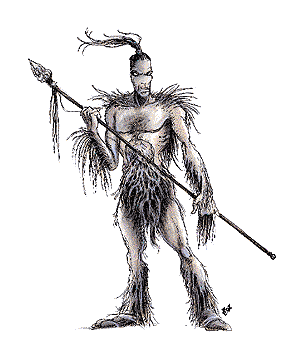

2140

| Climate/Terrain: | Tropical or subtropical moist forests and caverns |
|---|---|
| Frequency: | Very rare |
| Organization: | Tribe |
| Activity Cycle: | Any |
| Diet: | Carnivore |
| Intelligence: | Low (5-7) |
| Treasure: | O,P |
| Alignment: | Neutral |
| No. Appearing: | 6-24 or 30-300 |
| Armor Class: | 4 |
| Movement: | 12 |
| Hit Dice: | 1 to 6 |
| THAC0: | 1 or 2 HD: 19 3 or 4 HD: 17 5 or 6 HD: 15 |
| No. of Attacks: | 1 |
| Damage/Attack: | 1-6 or by weapon |
| Special Attacks: | See below |
| Special Defenses: | See below |
| Magic Resistance: | Nil |
| Size: | S-M (2-4�’) |
| Morale: | Average (8-10) |
| XP Value: | 1 HD: 120 2 HD: 175 3 HD: 270 4 HD: 420 5 HD: 650 6 HD: 2,000 |
Mold men, sometimes derogatorily called vegepygmies or even moldies, are short, bipedal fungus creatures. They have sharp, thorn-like claws, and leaf-like tendrils form a fringe on their shoulders, abdomens, and limbs. A topknot of these tendrils sits at the apex of a vegepygmy’s head.
The coloration of mold men matches their surroundings; forest mold men have brown skin and green tendrils, while those found underground might have gray skin and black tendrils. Mold men are 1� feet tall, plus �-foot per Hit Die.
Although they do not have a spoken language, vegepygmies are capable of vocalized cries. They normally communicate by tapping on their chests and on trees or stones.
Combat: Parties of mold men hunt near their lairs. In their home territory, mold men blend into their surroundings, so opponents receive a -2 penalty to surprise rolls.
Mold men will attack any form of animal life for food. Though capable of using their natural camouflage for ambush, they seldom use other tricks or traps, preferring direct assault.
Half of the mold men in a group have 1 HD, while 25% have 2 HD. The rest are 3 or 4 HD (equal chances). For every 50 mold men, there is a subchief with 5 HD and 1d4+1 bodyguards with 3 HD each. Each tribe of mold men is led by a chief with 6 HD and 2d4 bodyguards with 4 HD each.
Half of the mold men encountered carry spears, while the others use clubs or go without weapons (equal chances).
Chiefs also attack with spores; victims must make a saving throw vs. poison or be paralyzed, dying in 5d4 minutes unless treated by a cure disease spell. Victims who die in this manner are reborn 1d4+20 hours later as mold men with 4 HD. These individuals generally become the chief’s bodyguards. Attacks from piercing weapons cause only 1 point of damage to mold men. They are immune to electrical attacks, as well as all charm spells except those which affect plants. Mold men always receive saving throws vs. enchantments, even if one is not normally allowed.
About half of all of their hunting parties are accompanied by a pack of thornies as well. Mold men settlements always hold 1-4 packs of thornies.
Habitat/Society: Mold men form primitive, settled tribes. Their lairs are usually found in warm underground areas, though some tribes have lairs in the underbrush of deep, dark forests and jungles. Tribes are very territorial.
Mold men co-exist well with plant and fungus life. They often use shriekers to guard their lairs, and mold men native to the lair can pass by those shriekers unnoticed. Russet mold is usually found in the vicinity of a mold man lair as well.
New mold men are created by russet mold, by their leaders’ spore attacks, or by budding. The latter occurs only if food is plentiful. Russet molds produce 5 HD mold men, while leaders create 4 HD mold men, and normal budding produces 1 HD mold men.
Mold men have been known to associate with myconids, which view them as rustic cousins.
Ecology: Mold men live by scavenging and hunting. They will eat meat in any condition, from fresh to carrion. In times of great need, they have been known to eat other mold men, or even myconids, though they seldom attack members of their own or an allied tribe.

◆ 1299 ◆